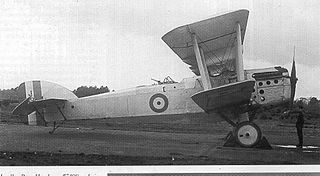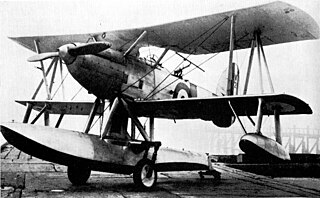
The Hawker Nimrod is a British carrier-based single-engine, single-seat biplane fighter aircraft built in the early 1930s by Hawker Aircraft.

The Fokker F.V was a Dutch airliner created by Fokker in the 1920s. The most interesting property of the F.V was that it could be configured either as a biplane or a monoplane, as the lower wing could be removed. It was not a success and only one was built.

The Blackburn T.R.1 Sprat was a British single-engine two-seat biplane trainer, built in 1926 for advanced training, deck-landing and seaplane experience. Just one was built.

The Blackburn 2F.1 Nautilus was a British single-engine two-seat biplane spotter/fighter built in 1929. Only one was completed.

The Westland Wizard was Westland Aircraft's first attempt to produce a monoplane fighter. The project was privately funded and the prototype design was done in the spare time of the company's engineers. This all happened during 1926, with high-speed performance as the primary goal.

The Gloster Goring was a single-engined two-seat biplane designed to meet 1926 Air Ministry specifications for a day/torpedo bomber. It was not put into production and the one aircraft built served later as an engine testbed.

The Gloster TSR.38 was a single-engined three-seat biplane designed as a naval torpedo/spotter/reconnaissance aircraft in the early 1930s. It did not reach production and only one was built.
The Fairey Fremantle was a large single-engine biplane seaplane designed in the mid-1920s for a proposed around-the-world flight. Only one was built.

The Fairey Fleetwing was a British two-seat, single-engine biplane designed to an Air Ministry contract for carrier-based reconnaissance operations in the late 1920s. Only one was built.

The Bristol Berkeley was built to a British government specification for a single-engine day or night bomber. Three of these two-seat biplanes were built, but no contract for further production was awarded.

The Vickers Type 253 was a single-engined two-seat biplane general-purpose military machine built to a 1930 government specification. It won a production contract, but this was transferred to the same company's monoplane equivalent, the Wellesley. Only one Type 253 was built.

The de Havilland DH.27 Derby was a large single-engined biplane designed to a heavy day bomber Air Ministry specification. It did not reach production.
The Fairey S.9/30 was a two-seat, single-engined biplane built to meet an Air Ministry specification for a fleet reconnaissance aircraft. It flew during 1934–36 in both land- and seaplane configurations. Although only one was built, it was the progenitor of the Fairey Swordfish.

The Westland F.7/30 was a British fighter prototype. A single prototype was built in 1934, but the type was not put in production because its performance fell far below the RAF's requirements. The Gloster Gladiator won the F.7/30 competition.

The Handley Page Handcross was a single-engined biplane day bomber built to an Air Ministry specification. It was not put into production and only the three prototypes were built.

The Handley Page H.P.43 was a three-engined biplane bomber-transport built to an Air Ministry specification. It did not fly well and the biplane configuration was out-dated at completion; the only one constructed was later turned into a monoplane and led to the Handley Page H.P.54 Harrow.
The Handley Page H.P.51 was a monoplane conversion of the earlier, unsuccessful biplane bomber-transport aircraft, the Handley Page H.P.43. The Air Ministry ordered the production variant off the drawing board as the Handley Page H.P.54 Harrow bomber.
The Parnall Perch was a single-engined, side-by-side-seat aircraft designed in the UK to meet an Air Ministry specification for a general-purpose trainer. Only one Perch was constructed, and no contract was ever awarded with this specification.

The Parnall Pipit was a single-engined, single-seat naval fighter designed to an Air Ministry specification in 1927. Two prototypes were built but both were destroyed by tail flutter.

The Short Gurnard was a single-engined two-seat biplane naval fighter, built in the United Kingdom to an Air Ministry specification in 1929. It failed to win production orders and only two flew.
















